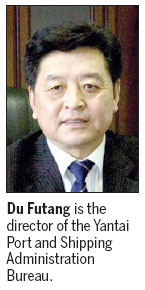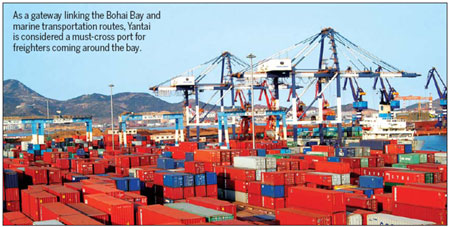Ocean of ambition
Updated: 2011-02-11 15:03
By Wang Chao (China Daily European Weekly)
|
|
Yantai is only 160 kilometers south of Dalian and 220 km south north of Qingdao, but living with prosperous neighbors is not necessarily a good thing.
|
 |
Yantai port finds it hard to compete with these strong and established coastal cities, although it also possesses deepwater wharfs and is close to international sea routes.
"In a way, we are being 'attacked' by the two and it is really hard for us to deal with them," says Zhang Xingru, deputy director general of the Bureau of Commerce of Yantai.
"Whatever industry we develop around the port, it might clash with the existing industries in Dalian and Qingdao, be it refinery, electronics or machinery."
Yantai was among the first ports that opened to the world in the 1860s. Back then, its tariff revenue made up 80 percent of the province's. However, its status dropped significantly after the Jiao-ji Railway was built in 1904. The railway connected Qingdao and major western cities in Shandong province and stretched out to other inland provinces. Since then, Qingdao has gradually taken over Yantai port as the most important port in Shandong.
Du Futang, director of the Yantai Port and Shipping Administration Bureau, says that lack of convenient railway connection between Yantai port and western Shandong cities forms the bottleneck for the port's development.
Normally, Yantai port is able to berth ships of about 100,000 tons. The annual cargo-handling capacity is 200 million tons while Dalian and Qingdao ports can berth ships up to 500,000 tons, and their annual cargo-handling capacity is more than 300 million tons.
During the 11th Five-Year Plan (2006-2010), Yantai developed another 26 berths for ships with 50,000 to 200,000 tonnages and another 86 capable of berthing ships more than 10,000 tons. However, it was still dwarfed by the performances of Qingdao and Dalian.
"I have to admit, there is some competition among us because of the geographic proximity," Du says. "But we are trying to collaborate with our neighbors rather than compete, since we share a lot of common interests."
Sharing the same economic hinterland, Yantai and Qingdao have signed a strategic cooperation agreement to build a Shandong international shipping center. Under this agreement, ocean-going freighters with huge tonnage departing from Bohai Bay can load first in Yantai and then in Qingdao port, before they sail out to the open sea.
"Outside of Shandong province, the cooperation between Yantai and other ports is initiated by companies which are searching for common interests," Du says.
As the gateway connecting the Bohai Bay and international marine transportation routes, Yantai is a must-cross port for freighters coming around the bay.
"This offers us a golden opportunity to become their transfer station and distribution center."
Located in northeastern Asia, Yantai found that its port's international customers were limited. About 90 percent of its international business partners are from the Republic of Korea and Japan.
"This year, we will open an international route together with Qingdao," Du says. It will also launch international routes to Europe, the US and Southeast Asia. "If a batch of goods needs to be processed and exported to Europe, it will be loaded in Yantai, processed in Qingdao and then be transported to Europe.
"In a word, we combine domestic and international cargo transportation," Du says.
The port is also trying to build its core competitiveness. "Qingdao has refinery and petrochemical industries, Dalian has its steel industry, while Tianjin has a high-end manufacturing industry backed by Beijing. We must build our own industry structure rather than copy theirs."
During the last five years, Yantai has invested more than 13 billion yuan (1.5 billion euros) to transform the existing port and build a new one. The new port will be located west of the existing one, cover an area of 50 square kilometers and have a coastline of 19.6 km. Once completed, it will be equipped with a total handling capacity of 200 million tons of cargo and 15 million containers. A tariff-free zone is being planned for the port for industries with "strong Yantai characteristics".
"Specialization is the key. The new port industries will focus on pollution-free agricultural products processing, wine products, and fertilizer manufacturing and distribution."
Situated north of the Shandong peninsula, at about the same latitude of Athens, Yantai is rich in fruit and vegetable crops. Last year, fertilizer exports hit 3.6 million tons.
As the existing port is surrounded by the city, there is no further land for expansion. It will be transformed into a port for luxury international cruises as well as liners to Dalian and the ROK. Wharfs for yachts will similarly be developed along the coastline but most of them will be operated by clubs, Du says.
But Du says Yantai's vision is far beyond catching up with its neighbors.
"By developing industries with local characteristics, we can form differentiated competition in this region and gain a say in international trade gradually.
"Currently, China doesn't have the pricing power of mineral resources, agricultural products and many other strategic resources. If our tariff-free zone attracts enough manufacturers and distributors in these fields, we might have more bargaining power in international trade.
"During the last five-year plan, we focused on the scale of expansion," he says.
"In the next five years, we will pay attention to modern logistics, specialized and environmentally friendly industries, and comprehensive services."
E-paper

Ear We Go
China and the world set to embrace the merciful, peaceful year of rabbit
Carrefour finds the going tough in China
Maid to Order
Striking the right balance
Specials

Spring Festival
The Spring Festival is the most important traditional festival for family reunions.

Top 10
A summary of the major events both inside and outside China.

China Daily in Europe
China Daily launched its European weekly on December 3, 2010.

